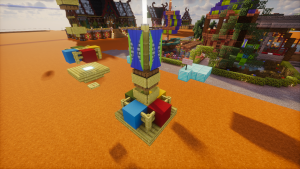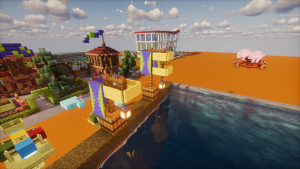Guide
How to contribute to the Connected Seas Coalition
From Dogcraft Wiki
This page contains all the information needed to contribute to and/or connect your base to the Connected Seas Coalition (CSC). The page is split into 2 main parts: Building your own port to connect to the CSC and other ways you can contribute to the CSC.
Connecting your base (or building a port in general)
Anyone can connect their base to the CSC by building a port that conforms to the standards of the CSC and notifying the CSC of the new port. Most of the requirements for a official CSC port are very simple to meet so really everyone can build a fully functional port!
Before you start, make sure that you meet the most important requirement for a CSC port: A connection to a ocean, river or other waterway. While you can build a port on a small lake, that isnt really useful as you cant actually go anywhere from that port. If you are only next to a small lake or no waterways at all, take a look at the surrounding area. Maybe there is a river or ocean not terribly far away and you can either build a canal or build the port there and connect it with a road of path to your base.
When choosing a location for a port, please keep in mind that the transport networks are NOT exempt from the server rules. This means your port has to follow all the server rules, including the 100-block rule, meaning that you need permission from your neighbour(s) if you want to build a port closer then 100 blocks to their build.
Building a port
A port is the main infrastructure of the CSC and the way for anything and anyone to connect to the CSC. A port is a location where players can transition from traveling on land to traveling on the water or vice versa. The primary functionality of a port is therefore to provide a place for players to get or deposit boats. These are generally regular boats, though you may provide a separate and clearly labelled dispenser for chest boats if you want. Ports however also provide some basic utilities such as beds and ender chests.
Here is a list of absolutely required features for a CSC port:
- Multiple well stocked boat dispensers (these can be as simple as a dispenser or dropper if on land with a button on it)
- Chests to return boats (these can just be chests labeled with signs or item frames. Using hoppers to connect them to the dispensers is optional)
- Beds
- Ender Chests
- Crafting Table (additional workstations are nice to have, but optional)
- A map of the surrounding area
- A Nether Portal connected to the NTN (if you have a portal nearby eg in your base that is sufficient as long as it is publicly accessible and easy to find from the port)
- Ports need to be spawn proof, including the roof
- Ports need to be easily navigable (in other words everything has to be easy to find. If locations might not be easily visible, use signs to point players in the correct direction)
- CSC Banners (You can get these at the spawn port or ask any CSC Master Navigator or Captain for a set and you may make as many copies as you want)
These following features are recommended, but not strictly required:
- A easy to find lodestone as well as several chests or barrels for lodestone compasses to this port and other ports
- A log book for visitors to leave a note
These features are nice to have, but entirely optional:
- An elevated platform or area to serve as a take-off point for elytra
- Nearby beacons with positive effects like regeneration
- Decorating the surrounding bodies of water (when doing this keep in mind that they need to remain easily navigable by boat)
- Connections to other transport networks like the RHN or SRN
If you have built a port with all the required features (and maybe even some of the optional ones), you can post it including some pictures in the "CSC Builds" thread in the "major-projects" forum in the transport discord and inform a CSC Master Navigator or CSC Captain of your port so we know it exists and we can add it to our wiki page.
Contributing to the CSC in other ways
Apart from building a port, there are also other ways to contribute to the CSC. These include providing/donating resources, building canals, buoys or signposts and helping to map the waterways and oceans of dogcraft.
Providing/Donating Resources
The CSC is operated by normal players like you and therefore we need to somehow get all the resources and materials we need to build ports, canals, buoys, signposts and more. We are always open for donations of materials and resources. If you are interested in donating any materials you can do so at the phome XPModder.DT-HQ. You can always ask any CSC Master Navigator or Captain about what resources are required the most at the moment. Also keep an eye on the open-tasks channel in the transport discord as we will post there when we need specific material for a project.
Building Canals
The CSC builds and operates canals to connect otherwise unconnected waterways to make travel by boat possible. Canals can be simple water filled trenches connecting two bodies of water or can have elaborate designs as long as some basic guidelines are followed. Canals can also be on top of viaducts or in tunnels underground and they can even traverse large height differences by using bubble columns to allow boats to go upwards.
When building a canal, the following things should be kept in mind:
- Is the canal necessary? - If there is a natural connection between both bodies of water nearby, building a buoy or signpost to point players in that direction might be a better idea
- Canals should be at least 4-5 blocks wide and 3 blocks deep to allow boats to pass each other
- Canal entrances on both ends should be easily visible
- Canals should have signs at/near them to show players where they lead
- Canals should have at least one way for players to cross over from one side to the other (on above-ground canals this can be a bridge, on viaducts this can be a simple opening at ground level underneath the waterway and for tunnels nothing has to be done as the terrain above provides this already)
- Canals should have a way to get out of the water somewhere in the middle of the canal (this could be a ladder, or in case the edge of the canal is at the same level as the water this is already possible without adding anything)
Canals should also be posted in the "CSC Builds" thread in the "major-projects" forum in the transport discord once completed. If your canal fulfills all requirements above, you may also post CSC banners at it. Check at the spawn ports or contact a CSC Master Navigator or Captain if you need CSC Banners.
Building Buoys or Signposts
Buoys and Signposts are used to help players navigate rivers and oceans on dogcraft. They contain signs that show players which direction to go to get to a certain port or location. Buoys and Signposts should be built at any place where multiple directions are available (eg where one river splits into two, or in a large ocean). While buoys and signposts have the same purpose they are suitable for different areas.
Buoys are more suitable for large bodies of water, especially oceans, as they are larger and thus easier to spot from a distance. They also "float" making them ideal to be built in the middle of an ocean with no land in sight.
Signposts are smaller and better suited for rivers and canals as they are placed on land (at the edge of the water) and thus do not take up valuable space in a narrow river. As they are designed to be placed on land they are not suited to be built in the middle of a body of water.
For both buoys and signposts, standard designs are available. The respective section below contains images of these standard designs and a version of each can be found at either spawn port ingame.
Buoys
Buoys contain colored blocks indicating the compass direction and signs indicating the direction to go to nearby ports or other points of interest. Buoys act as waypoints on a journey.
The colored concrete indicates the compass direction as follows:
- Light Blue - North
- Green - East
- Yellow - South
- Red - West
This coloring scheme is also used by the NTN and the SRN to color code their tunnels and rail lines respectively
Buoys follow a standardised design, which consists of the following:
- Bamboo stairs placed upside down in the top most water layer forming a ring
- 1 sea lantern in the center of this ring
- Concrete blocks in light blue, green, yellow and red placed on top of the bamboo stairs and pointing in the compass directions as mentioned above
- 2 bamboo trapdoor, one placed on the underside of the sea lantern and one placed at the top of the concrete blocks in the center
- Bamboo fence placed in the 4 corners on top of the bamboo stairs, one on top of the trapdoor and 2 on top of the barrel
- A barrel in between the bamboo fence, 2 blocks above the water
- One end rod on top of the top most bamboo fence
- 4 CSC banners placed on all 4 sides of the top most bamboo fence
- Signs placed on all 4 sides of the barrel and the bamboo fence below the barrel
- Should 2 signs per direction be not enough, additional signs can be placed on the outward facing sides of the concrete blocks
When writing the signs on a buoy, care should be taken about the amount of space used for one entry. Ideally each port or point of interest should not take up more then 1 line on the sign, to allow as many destinations as possible to be marked on one buoy.
Signposts
Signposts use a simple standardised design and are placed on the shore of rivers, especially at river junctions. The signs located on the signposts are used to indicate in which direction nearby ports or other points of interest are. They provide an immense help for navigating large river systems, where even lodestone compasses can fail the traveller. Signposts consist mainly of the following:
- A barrel which can contain additional boats in case a boat is lost during the journey
- Spruce fence forming a 2-4 high post with an additional fence one block out over the water attached to the side of the highest other fence
- Between 3 and 9 signs depending on need and height of the fence post and placed on three sides of the single fence to the side and of any chains used
- Up to 2 chains and 1 lanterns. the lantern being hung from the single fence at one block above the water surface. chains are used to between the fence and the lantern when needed
- 3 CSC banners, placed on 3 sides of the highest fence post
Further questions
For any further questions, you can read the article on the CSC or approach any CSC Master Navigator or Captain.


